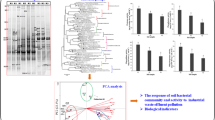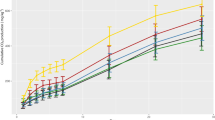Abstract
Purpose
Hexachlorocyclohexane (HCH) is a pesticide that is persistent in aerobic but not in anaerobic conditions. The aim of this investigation was to elucidate the impacts of different electron donors on the degradation of hexachlorocyclohexane and their relationships with the microbial community in submerged soils.
Materials and methods
Soil samples were collected from a pesticides-polluted site which was previously used for long-term storage of pesticides since the 1960s. Residual amounts of HCHs in submerged soils were assessed to evaluate the efficiency of the added electron donors after incubation. Changes in microbial community were monitored during incubation.
Results and discussion
The efficiencies of removal of HCHs by Fe0, Fe0 + straw and glucose treatments were 63.8%, 40.3%, and 22.0%, compared with 5.4% by the control. Soil redox potential decreased rapidly following addition of Fe0 and became anaerobic, but there was no significant decrease in redox potential following the addition of glucose. Principal coordinates analysis (PCoA) confirms that the electron donors greatly affected the soil bacterial community. Furthermore, community composition analysis shows that Firmicutes was the dominant phylum after addition of carbon sources (straw and glucose) but Proteobacteria were dominant in the control and the Fe0 treatment. Prauserella, Actinobacteria, and Streptomyces showed highly significant increases in the Fe0 treatment and were positively correlated with total HCH residues.
Conclusions
These findings indicate that the addition of organic materials (straw and glucose) had a gradual effect on the degradation of HCH while Fe0 acted rapidly. Elucidation of the relationships between electron donors and soil microbial communities will help in the bioremediation of HCH-contaminated sites.







Similar content being viewed by others
References
Adrian L, Löffler FE (2016) Organohalide-respiring bacteria. Springer-Verlag, Berlin Heidelberg
Alvarez A, Benimeli CS, Saez JM, Fuentes MS, Cuozzo SA, Polti MA, Amoroso MJ (2012) Bacterial bio-resources for remediation of hexachlorocyclohexane. Int J Mol Sci 13:15086–15106
Ammeri RW, Mehri I, Badi S, Hassen W, Hassen A (2017) Pentachlorophenol degradation by Pseudomonas fluorescens. Water Qual Res J Can 52:99–108
Anh TPN et al (2011) Characterization of the 1,1-dichloro-2,2-bis(4-chlorophenylln ethylene (DDE)) degradation system in janibacter sp TYM3221. Enzym Microb Technol 49:532–539
Badea SL, Vogt C, Weber S, Danet AF, Richnow HH (2009) Stable isotope fractionation of gamma-hexachlorocyclohexane (lindane) during reductive dechlorination by two strains of sulfate-reducing bacteria. Environ Sci Technol 43:3155–3161
Benimeli CS, Castro GR, Chaile AP, Amoroso MJ (2006) Lindane removal induction by Streptomyces sp M7. J Basic Microbiol 46:348–357
Benimeli CS, Castro GR, Chaile AP, Amoroso MJ (2007) Lindane uptake and degradation by aquatic Streptomyces sp strain M7. Int Biodeterior Biodegrad 59:148–155
Chen M, Liu C, Li X, Huang W, Li F (2014) Iron reduction coupled to reductive dechlorination in red soil. Soil Sci 179:457–467
Chen M, Tong H, Li F, Liu C, Lan Q, Liu C (2018) The effect of electron donors on the dechlorination of pentachlorophenol (PCP) and prokaryotic diversity in paddy soil. Eur J Soil Biol 86:8–15
Cong X, Xue N, Wang S, Li K, Li F (2010) Reductive dechlorination of organochlorine pesticides in soils from an abandoned manufacturing facility by zero-valent iron. Sci Total Environ 408:3418–3423
Cong X, Li FS, Kelly RM, Xue ND (2018) Distribution and removal of organochlorine pesticides in waste clay bricks from an abandoned manufacturing plant using low-temperature thermal desorption technology. Environ Sci Pollut Res 25:12119–12126
Cruz-Gonzalez G et al (2018) Degradation of chlordecone and beta-hexachlorocyclohexane by photolysis, (photo-)Fenton oxidation and ozonation. J Environ Sci Health Part B Pestic Contam Agric Wastes 53:121–125
Cui ZJ, Meng FL, Hong JL, Li XZ, Ren XH (2012) Effects of electron donors on the microbial reductive dechlorination of hexachlorocyclohexane and on the environment. J Biosci Bioeng 113:765–770
Dominguez CM, Oturan N, Romero A, Santos A, Oturan MA (2018) Removal of lindane wastes by advanced electrochemical oxidation. Chemosphere 202:400–409
Elcey CD, Kunhi AAM (2010) Substantially enhanced degradation of hexachlorocyclohexane isomers by a microbial consortium on acclimation. J Agric Food Chem 58:1046–1054
Fan YT, Zhang YH, Zhang SF, Hou HW, Ren BZ (2006) Efficient conversion of wheat straw wastes into biohydrogen gas by cow dung compost. Bioresour Technol 97:500–505
Gao YF, Yang H, Zhan XH, Zhou LX (2013) Scavenging of BHCs and DDTs from soil by thermal desorption and solvent washing. Environ Sci Pollut Res 20:1482–1492
Huang Y, Pan H, Wang Q, Ge Y, Liu W, Christie P (2019) Enrichment of the soil microbial community in the bioremediation of a petroleum-contaminated soil amended with rice straw or sawdust. Chemosphere 224:265–271
Lal R, Pandey G, Sharma P, Kumari K, Malhotra S, Pandey R, Raina V, Kohler HP, Holliger C, Jackson C, Oakeshott JG (2010) Biochemistry of microbial degradation of hexachlorocyclohexane and prospects for bioremediation. Microbiol Mol Biol Rev 74:58–80
Lane DJ (1991) 16S/23S rRNA sequencing. Nucleic acid techniques in bacterial systematics, pp 115–175
Langenhoff AAM, Staps SJM, Pijls C, Rijnaarts HHM (2013) Stimulation of hexachlorocyclohexane (HCH) biodegradation in a full scale in situ bioscreen. Environ Sci Technol 47:11182–11188
Li YF (1999) Global technical hexachlorocyclohexane usage and its contamination consequences in the environment: from 1948 to 1997. Sci Total Environ 232:121–158
MacRae IC, Yamaya Y, Yoshida T (1984) Persistence of hexachlorocyclohexane isomers in soil suspensions soil. Biol Biochem 16:285–286
Mansouri A, Cregut M, Abbes C, Durand MJ, Landoulsi A, Thouand G (2017) The environmental issues of DDT pollution and bioremediation: a multidisciplinary review. Appl Biochem Biotechnol 181:309–339
Middeldorp PJM, van Doesburg W, Schraa G, Stams AJM (2005) Reductive dechlorination of hexachlorocyclohexane (HCH) isomers in soil under anaerobic conditions. Biodegradation 16:283–290
Ni MF, Tian SL, Huang QF, Yang YM (2018) Electrokinetic-Fenton remediation of organochlorine pesticides from historically polluted soil. Environ Sci Pollut Res 25:12159–12168
Papale M, Giannarelli S, Francesconi S, di Marco G, Mikkonen A, Conte A, Rizzo C, de Domenico E, Michaud L, Giudice AL (2017) Enrichment, isolation and biodegradation potential of psychrotolerant polychlorinated-biphenyl degrading bacteria from the Kongsfjorden (Svalbard Islands, High Arctic Norway). Mar Pollut Bull 114:849–859
Phillips TM, Lee H, Trevors JT, Seech AG (2006) Full-scale in situ bioremediation of hexachlorocyclohexane-contaminated soil. J Chem Technol Biotechnol 81:289–298
Sadiq S, Mahmood-ul-Hassan M, Ahad K, Nazir S (2018) Bioremediation of hexachlorocyclohexane (HCH) in soil using spent mushroom compost of Pleurotus ostreatus. Bioremediat J 22:126–135
Sahoo B, Ningthoujam R, Chaudhuri S (2019) Isolation and characterization of a lindanedegrading bacterium Paracoccus sp. NITDBR1 and evaluation of its plant growth promoting traits. Int Microbiol 22:155–167
Shoiful A, Ueda Y, Nugroho R, Honda K (2016) Degradation of organochlorine pesticides (OCPs) in water by iron (Fe)-based materials. J Water Process Eng 11:110–117
Sineli PE, Tortella G, Davila Costa JS, Benimeli CS, Cuozzo SA (2016) Evidence of alpha-, beta- and gamma-HCH mixture aerobic degradation by the native actinobacteria Streptomyces sp M7. World J Microbiol Biotechnol 32:1–9
Sun GD, du Y, Yin J, Jiang Y, Zhang D, Jiang B, Li G, Wang H, Kong F, Su L, Hu J (2019) Response of microbial communities to different organochlorine pesticides (OCPs) contamination levels in contaminated soils. Chemosphere 215:461–469
Vergani L, Mapelli F, Suman J, Cajthaml T, Uhlik O, Borin S (2019) Novel PCB-degrading Rhodococcus strains able to promote plant growth for assisted rhizoremediation of historically polluted soils. PLoS One 14:e0221253
Wang B et al (2017) Biosurfactant-producing microorganism Pseudomonas sp. SB assists the phytoremediation of DDT-contaminated soil by two grass species. Chemosphere 182:137–142
Xu Y, Niu L, Qiu J, Zhou Y, Lu H, Liu W (2018) Stereoselective accumulations of hexachlorocyclohexanes (HCHs) are correlated with Sphingomonas spp. in agricultural soils across China. Environ Pollut 240:27–33
Yang SC, Lei M, Chen TB, Li XY, Liang Q, Ma C (2010) Application of zerovalent iron (Fe(0)) to enhance degradation of HCHs and DDX in soil from a former organochlorine pesticides manufacturing plant. Chemosphere 79:727–732
Yang CW, Huang HW, Chang BV (2017) Microbial communities associated with anaerobic degradation of polybrominated diphenyl ethers in river sediment. J Microbiol Immunol Infect 50:32–39
Funding
We thank the National Natural Science Foundation of China (U1662110, 41877141) and National Science and Technology Major Project (2018YFC1801301-002) for financial support.
Author information
Authors and Affiliations
Corresponding author
Ethics declarations
Conflict of interest
The authors declare that they have no conflict of interest.
Research involving Human Participants and/or Animals
This article does not contain any studies with human participants performed by any of the authors.
Informed consent
Informed consent was obtained from all individual participants included in the study.
Additional information
Responsible editor: Dong-Mei Zhou
Publisher’s note
Springer Nature remains neutral with regard to jurisdictional claims in published maps and institutional affiliations.
Rights and permissions
About this article
Cite this article
Zhao, Y., Zhang, Y., Wang, J. et al. Effects of electron donors on the degradation of hexachlorocyclohexane and microbial community in submerged soils. J Soils Sediments 20, 2155–2165 (2020). https://doi.org/10.1007/s11368-020-02593-4
Received:
Accepted:
Published:
Issue Date:
DOI: https://doi.org/10.1007/s11368-020-02593-4




